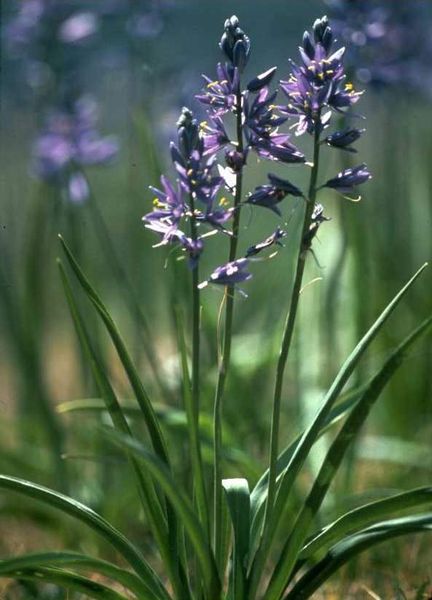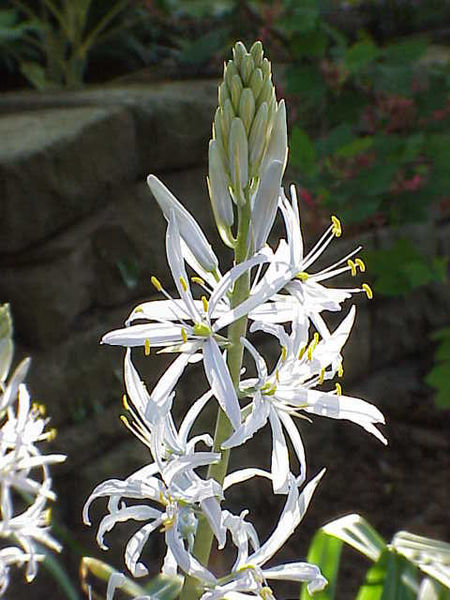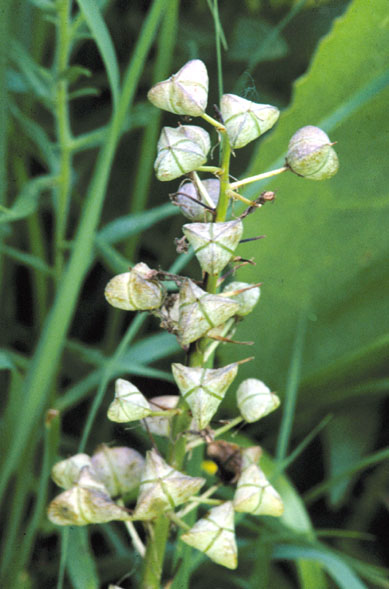Camassia
Camassia is a genus of six species native to western North America, from southern British Columbia to northern California, and east to Utah, Wyoming and Montana. Historically, the genus was thought to belong to the lily family (Liliaceae), the Scilloideae family, or the Hyacinthinaceae family, but from DNA and biochemical studies, the APG II-group has reassigned Camassia to the family Agavaceae. Common names include Camas, Quamash, Indian hyacinth, and Wild hyacinth.
Camas grow in the wild in great numbers in moist meadows. They are perennial plants with basal linear leaves 20–80 cm long, which emerge early in the spring. They grow to 30–130 cm tall, with a multi-flowered stem rising above the main plant in summer. The six-petaled flowers vary in color from pale lilac or white to deep purple or blue-violet. They sometimes color whole meadows.
This bulbflower naturalizes well in gardens. The bulb grows best in well-drained soil high in humus. It will grow in lightly shaded forest areas and on rocky outcrops as well as in open meadows or prairies. Additionally it is found growing alongside streams and rivers. The plants may be divided in autumn after the leaves have withered. Bulbs should be planted in the autumn. Additionally the plant spreads by seed rather than by runners.
The Quamash was a food source for quite a number of native peoples in the western United States and Canada. After being harvested in the autumn, once the flowers have withered, the bulbs were pit-roasted or boiled. A pit-cooked camas bulb looks and tastes something like baked sweet potato, but sweeter, and with more crystalline fibers due to the presence of inulin in the bulbs. When dried, the bulbs could be pounded into flour. Native American tribes who ate camas include the Nez Perce, Cree, Coast Salish, Lummi, and Blackfoot tribes, among many others. Camas bulbs contributed to the survival of members of the expedition of Lewis and Clark (1804-1806).
Though the once-immense spreads of camas lands have diminished because of modern developments and agriculture, numerous Camas prairies and marshes may still be seen today.
References
- Brisland, Richard T. W. Camas processing or upland hunting : an interpretation of lithic scatters at High Prairie. Calgary, Alb.: University of Calgary, 1992. Thesis (M.A.)
- Comber, Harold F.; Miller, Murray. Check list of the plants of the Camassia Natural Area : vascular plants. [Oregon]: Oregon Chapter, The Nature Conservancy, 1967
- Coville, Frederick V. (1897). The technical name of the camas plant. Proceedings of the Biological Society of Washington 11: 61-65.
- Gould, Frank W. A systematic treatment of the genus Camassia Lindl. Notre Dame, Ind.: University Press, 1942.
- Konlande, J. E.; Robson, John R. (1972). The nutritive value of cooked camas as consumed by Flathead Indians. Ecology of food and nutrition 2: 193-195.
- Maclay, Anne M. Studies of the life history of Camassia quamash (Pursh) Greene. Pullman, Wash., State College of Washington (Washington State University), 1928. Thesis (M.S.)
- Rice, Peter M.; Toney, J. Chris.; Cross, Marcia Pablo. Rehabilitation of camas and bitterroot gathering sites: study plan. [Hamilton, Mont: Bitterroot National Forest: U.S. Forest Service], 1996.
- Smith, Harriet L. Camas: the plant that caused wars. Lake Oswego, Or.: Smith, Smith and Smith Pub. Co., 1978.
- Stevens, Michelle L. and Darris, Dale C. Plant Guide for Common Camas: Ethnobotany, Culture, Management, and Use. Plant Materials Technical Note No. 25. (June 16, 2000) U.S. Department of Agriculture Natural Resources Conservation Service, Portland, Oregon, 2000.
- Stevens, Michelle L. and Darris, Dale C. Ethnobotany, Culture and Use of Great Camas (Camassia quamash ssp. quamash). Plant Materials Technical Note No. 23 (September 1999). U.S. Department of Agriculture Natural Resources Conservation Service, Portland, Oregon, 1999
- Storm, Linda. Patterns and Processes of Indigenous Burning 2000
- Statham, Dawn Stram. Camas and the Northern Shoshoni: a biogeographic and socioeconomic analysis. Boise, Idaho: Boise State University, 1982.
- Thoms, Alston V. The northern roots of hunter-gatherer intensification: camas and the Pacific Northwest. Pullman, Wash.: Thesis (Ph. D.)--Washington State University, 1989.
- Toney, J. Chris. Traditional plant restoration: restoration of camas & bitterroot gathering sites (phase I-year 1 progress report). [Hamilton, Mont: Bitterroot National Forest: U.S. Forest Service], 1997
From Wikipedia, the free encyclopedia
|



|


